History
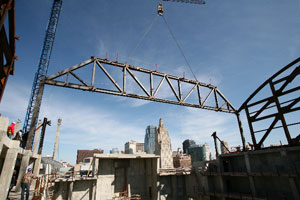 First Steel Truss is Installed
First Steel Truss is Installed
How do you get a 50-ton truss to the top of the Kauffman Center roof? With a really strong crane that can reach across the concrete base of the center and an experienced crew of steel installers carefully guiding it into place.
That’s why there’s a new crane in town. And it went to work on March 11, hoisting the first gigantic steel truss to the top of the Concert Hall. And while the center needs a roof for the obvious reasons, this part of the steel installation takes an important step toward completing the acoustic enclosure that will ensure great arts experiences.
The Kauffman Center construction site acquired a third large crane in early March. This bright red, white, and blue Demag 1800 is classified as a “600 ton crane” and was needed for several reasons.
“This crane has the ability to do “˜picks’ of 90 tons, which is required by the Kauffman Center specifications,” according to Kyle McQuiston, project executive for JE Dunn Construction. A “pick” refers to a load that is picked up, then maneuvered into place by the crane. “Plus this crane has the ability to reach out far enough, with that size load, to place the truss above the large concrete structure below,” McQuiston explains.
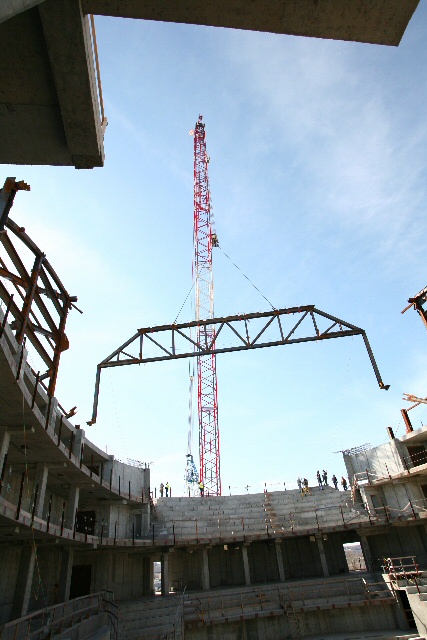 The first steel truss took just under an hour to lift into place above the Concert Hall. The trusses themselves are too large to be trucked in, so workers first must assemble and weld them together on site. The largest truss to be installed weighs 90 tons.
The first steel truss took just under an hour to lift into place above the Concert Hall. The trusses themselves are too large to be trucked in, so workers first must assemble and weld them together on site. The largest truss to be installed weighs 90 tons.
In order to reach everywhere that this crane’s special capacities are required, it will be moved three times during this phase of steel installation (to both the south and north sides of each hall). The two tower cranes currently on site cannot handle loads of this magnitude, but are required to assist the large mobile crane with connection pieces.
This new crane arrived with its own operator and will be on site for several months. “The project has the most detailed hoisting plan I’ve seen in 25 years of construction projects,” says McQuiston, as he points to a very large document on his desk. In addition, moving the crane is a major project, taking a week to ten days, as the crane must be dismantled in order to be relocated.
Construction rubberneckers on the street downtown will have a great time watching this crane do its work if the hoisting of the first truss is any indication. Even seasoned construction workers on site took time to watch the crane gingerly and precisely place tons of steel up on the roof.
- View the latest construction photos.
- Read more about the steel installation.
 For the last 10 years, Kansas City patrons have become accustomed to enjoying opera in its original language, aided by supertitle translations of lyrics and dialogue projected above the stage at the Lyric Theatre.
For the last 10 years, Kansas City patrons have become accustomed to enjoying opera in its original language, aided by supertitle translations of lyrics and dialogue projected above the stage at the Lyric Theatre.
At the Kauffman Center, audiences will have an even more personalized way to enjoy opera through an advanced titling system now being used in many theaters around the country. Each patron can choose to see the titles right at their seat. Or not. How’s that possible? “Figaro! Figaro!”
Figaro’s Simultext ® is an innovation that came about over margaritas at Maria’s in Sante Fe. The accompanying conversation was about how to make performances more accessible for patrons who had difficulty hearing at the Sante Fe Opera.
Afterwards, founder Patrick Markle worked with two other opera professionals to devise the first prototype of a personal device that takes titles directly to patrons’ seats. They soon saw that it had benefits for all theater-goers. “We think of it as a dashboard for the arts and more,” Markle says.
As a result, the Kauffman Center’s Proscenium Theatre will be outfitted with small screens behind each seat that provide the ultimate in personal choice. Markle likes to say that, with Figaro Simultext ®, “Titles are put in their place — where each patron can see them if they want and when they want.”
Similar systems are currently in use at the Seattle Opera House, the New York Metropolitan Opera, Sante Fe Opera, London’s Royal Opera House, the Vienna State Opera and the Grand Teatro del Liceu in Barcelona, Spain.
The system can deliver the words sung or spoken by single or multiple performers, three lines of text to each screen. Patrons decide if they want to see the titles and then they select the language of their choice. If they choose not to see titles, they simply touch the “off button” on their individual screen.
“The Figaro System has many advantages for our patrons,” says Ward Holmquist, musical director for the Kansas City Lyric Opera. “There will be no more “˜blind spots’ where titles can’t be read. Plus, audience members close to the stage will no longer have to crane their necks to see the titles.”
The Ballet could use the system to provide scene synopses. A lecturer speaking in Russian could be translated for the audience — in up to six languages. A theatre company could provide programming notes, casting changes or welcome a particular group of ticket holders.
Each screen is ergonomically placed just below the audience member’s view of the stage, well within a comfortable viewing angle. Importantly, each unit has a “privacy screen” so that they do not interfere with a neighbor’s enjoyment of what’s on stage.
In addition, the screens have soft lighting, not a TV-like glare. The OLED screens (organic light emitting diodes) display clear text in six languages and can fade fully, meaning that they do not constantly glow (like an LCD screen does). Plus, they are ultra-low in energy consumption.
“We’re grateful that a number of donors helped us to make Figaro available for Kansas City audiences,” says Jane Chu, President and CEO of the Kauffman Center. “It’s just one more way to assure that future performing arts experiences will be exceptional and available for everyone.”
Learn more about the Proscenium Theatre. Read theater designer Richard Pilbrow’s thoughts on a range of theatre design details.
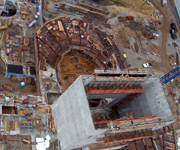 Right now the stage tower is the tallest structure at the Kauffman Center construction site, clearly visible from a car driving down Broadway. However, the huge stage tower, seen in the lower right corner of this aerial photo, will soon be hidden out of sight by steel and even more concrete.
Right now the stage tower is the tallest structure at the Kauffman Center construction site, clearly visible from a car driving down Broadway. However, the huge stage tower, seen in the lower right corner of this aerial photo, will soon be hidden out of sight by steel and even more concrete.
So what precisely will go on inside this 74-foot tall structure rising above the stage? Flying scenery, catwalks and a huge loading dock are in the works, all eagerly anticipated by two resident companies, the Kansas City Ballet and the Lyric Opera.
In the Kauffman Center’s 1,800 seat proscenium theatre, the audience will sit facing the stage and view performances through a rectangular opening, like they do at many Kansas City venues. However, most comparisons stop there.
Above the stage where the Kansas City Ballet and the Lyric Opera will perform, looms a 74-foot tall stage tower that plays a critical role in the theatrical experience. Its volume and rigging systems will allow technical crews to hang lighting, sets and other equipment directly above the stage area — and lower onto the stage as needed.
According to Michael Ferguson, project manager for Theatre Projects Consultants, the Kauffman Center has a “full-height stage tower that allows for full-height scenery to be completely flown above the stage.” This means that, in the proscenium theatre, sets as tall as 30 feet can be flown above the stage and tucked completely out of sight.
“It should expand our capacity to stage a production in cooperation with the larger opera companies,” remarks Evan Luskin, general manager of the Lyric Opera. “In the past we were often the smallest company and joint productions often had to be scaled back to accommodate our space restrictions.”
“We would like now and again to produce more of the full-length story ballets similar to our successful Romeo and Juliet last season,” shares Jeffrey Bentley, executive director of the Kansas City Ballet. “Most of our brethren companies, from whom we rent sets and costumes, almost always perform in larger halls and build their full-length productions on a scale that doesn’t work for us in the Lyric.”
At the highest level of the tower is a fully walkable rigging grid, something missing from many stage towers due to height restrictions. Technicians access this steel structure by elevator or stairs. They can then walk above the fly loft to adjust the lift lines and loft-blocks of the counterweight system. Theaters without this space have fixed, less flexible, systems.
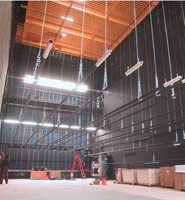 The tower also houses state-of-the-art rigging and lighting systems. Rigging (like those shown in the small stage tower to the right) allows equipment on the stage to be raised, lowered, rotated and moved from side to side. It also serves practical functions, like hanging and masking lighting and provides dramatic effect when used to move scenery and arrange draperies.
The tower also houses state-of-the-art rigging and lighting systems. Rigging (like those shown in the small stage tower to the right) allows equipment on the stage to be raised, lowered, rotated and moved from side to side. It also serves practical functions, like hanging and masking lighting and provides dramatic effect when used to move scenery and arrange draperies.
Two catwalks, called galleries, are positioned on each side of the stage house. A mid-gallery catwalk is in place specifically for automated use during a production. “This is an accommodation for modern scenic techniques that use a lot of motorized or tracking scenery,” Ferguson explains. Galleries are used to hang scenery, to feed electrical and dimming equipment and to access the counterweight fly system.
A flexible proscenium opening is another feature of this hall. The width of the stage opening can be adjusted from 40 to 50 feet. A set designer or director can adjust the proscenium opening to a particular size for a show, using movable panels. Once in place the proscenium opening appears to the audience as finished, tailored and part of the architecture. The visual height of the opening can also be adjusted.
According to Ferguson, “This makes the stage tremendously flexible. A smaller ballet, for example, won’t feel lost on the stage, while a Wagner opera will have plenty of space for the large scenery and cast.” Ferguson emphasizes that all dimensions are tailored to the size of this particular hall. “We’ve worked very hard with the architect, Moshe Safdie, to make both halls intimate, with audiences as close to performers as possible.”
Learn more about the proscenium theatre. Also read a conversation with Richard Pilbrow, theater designer with Theater Projects Consultants.
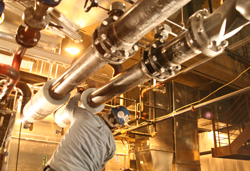 Construction Continues in the Cold
Construction Continues in the Cold
Passers-by can readily see steel installers braving Kansas City’s lowest temperatures to erect the Kauffman Center’s steel skeleton. However, it’s difficult to see if anything else is happening on site during these often harsh months.
Below the two performance halls, in the areas called “back of house” in theater parlance, more than 25 people are hard at work. And while their work is focused on infrastructure we often take for granted, things like acoustics and audience comfort are constantly driving decisions and construction.
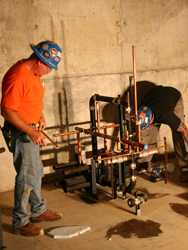 To allow interior work to move ahead simultaneously with steel installation, a supplemental waterproofing plan was developed. This means that utility spaces below street level remain dry and crews can work there and install sensitive equipment even in winter weather. In addition, elevator and escalator openings have been enclosed to keep out rainwater, snow and ice. “Generally waterproofing is a much later step in construction,” says Dwight Davis, mechanical-electrical coordinator for JE Dunn Construction. “But our approach has allowed work to move forward in multiple places at the site.”
To allow interior work to move ahead simultaneously with steel installation, a supplemental waterproofing plan was developed. This means that utility spaces below street level remain dry and crews can work there and install sensitive equipment even in winter weather. In addition, elevator and escalator openings have been enclosed to keep out rainwater, snow and ice. “Generally waterproofing is a much later step in construction,” says Dwight Davis, mechanical-electrical coordinator for JE Dunn Construction. “But our approach has allowed work to move forward in multiple places at the site.”
As a result, workers are installing ductwork and equipment needed to drive the Kauffman Center’s displacement air system, which has been designed to reduce any sounds from heating or cooling being pumped into the halls. The ductwork is sized as large as possible to maximize the volume of air delivered and to reduce its velocity (and hence, any noise it might make). “Some of the ductwork is large enough to drive a car through,” says Davis.
Special steps are even being taken within the ductwork. In most buildings, ductwork is installed, then insulated. In the Kauffman Center, the inside of the ductwork is being insulated. As a result, any sound generated in the ducts (such as air rounding a corner) will be deadened.
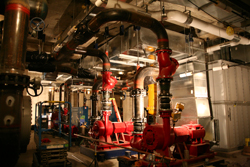 Chillers, boilers and fans can develop annoying sounds. “Every pump, every fan, every machine that has some mechanical moving part has a degree of isolation that is rarely seen on a project,” says Davis.
Chillers, boilers and fans can develop annoying sounds. “Every pump, every fan, every machine that has some mechanical moving part has a degree of isolation that is rarely seen on a project,” says Davis.
In the Kauffman Center equipment like this is being mounted on spring isolators so that if they do move or shake, the building itself will not absorb the sound. Think of your washing machine getting out of balance. The loud noise comes from the machine reverberating against the floor (or even walls). This won’t happen with Kauffman Center equipment, as it has been “spring hung.”
No potential source of sounds that might interrupt performances has been missed in the planning for these halls. Even electrical transformers, which can “hum” a bit, are being isolated as far as possible from performance areas. “The only humming we want to hear is from performers on stage and audience members as they leave, tunes running happily through their heads,” says Jane Chu, president and CEO of the Kauffman Center.
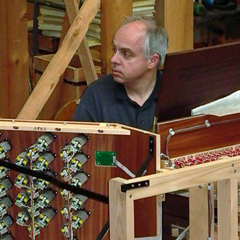
Concert Hall Organ Takes Shape in Montreal
How many architects, designers, organ consultants, builders, installers and semi-trailers does it take to put an exceptional organ inside the Kauffman Center concert hall?
There’s no underlying joke here. Creating our concert hall organ is a gigantic project that will take two years of intense work. “At the end, it will arrive at the hall as a big puzzle ready to be carefully assembled and tonally finished to be in consonance with the acoustic space,” says Jacquelin Rochette, tonal director with organ builder Casavant Frères in Montreal.
Our conversation with Rochette outlines the organ design and building process, already well underway.
Where does one begin to create a grand concert hall organ like ours?
 Rochette This multi-phase process will take two years and is intensely collaborative. The first steps involve Casavant working with the Kauffman Center to define the various specifications for the organ, going from the organ disposition and choice of action to selection of the various voices. And we take into account the various requirements such as blower room, air intake, temperature and humidity control plus mechanical and electrical requirements.
Rochette This multi-phase process will take two years and is intensely collaborative. The first steps involve Casavant working with the Kauffman Center to define the various specifications for the organ, going from the organ disposition and choice of action to selection of the various voices. And we take into account the various requirements such as blower room, air intake, temperature and humidity control plus mechanical and electrical requirements.
We are working with acoustical consultant Yasu Toyota, and organ consultant James David Christie, two experts who are great leaders in their fields and are recognized all around the world for their knowledge and experience. As a result of this part of the process, we create and sign off on what we call the “specification of the instrument.”
Concert Hall Organ Takes Shape in Montreal
Once we’ve reached that point, we are able to develop drawings of the interior of the instrument and of all the components. This includes the chests, the wooden boxes containing all the mechanisms that will enable the organist to play the instrument. Also the mechanical action and its hundred of feet of wooden linkages, the pipes, the stop action and other controls at the disposition of the organist. These “ensemble drawings” have been completed for months, and we are currently completing all the detailed drawings and making final choices to insure the most responsive “key action” or “key touch.”
How does the Casavant team interact with architect Moshe Safdie?
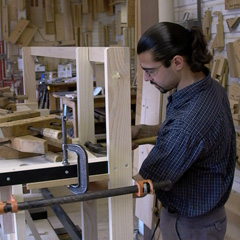 We have already established with Moshe the location of the organ departments (five divisions on four keyboards and pedalboard) and various pipes. It is an honor for us to work with an architect the caliber of Moshe Safdie. A member of our team and colleague, designer Didier Grassin, is working closely with Moshe to create the visual design of the organ in the hall. We want the parts of the organ that the audience sees to reflect Safdie’s vision for the hall and is compatible to the organ mechanisms, to its use and functions, and to its tonal concept. This process is very collaborative and is still unfolding, so I can’t share any details. We do know, however, that Safdie will be using some of the wooden pipes of the instrument to develop a visual texture that will contrast with the interior design.
We have already established with Moshe the location of the organ departments (five divisions on four keyboards and pedalboard) and various pipes. It is an honor for us to work with an architect the caliber of Moshe Safdie. A member of our team and colleague, designer Didier Grassin, is working closely with Moshe to create the visual design of the organ in the hall. We want the parts of the organ that the audience sees to reflect Safdie’s vision for the hall and is compatible to the organ mechanisms, to its use and functions, and to its tonal concept. This process is very collaborative and is still unfolding, so I can’t share any details. We do know, however, that Safdie will be using some of the wooden pipes of the instrument to develop a visual texture that will contrast with the interior design.
Note: The Concert Hall organ will have 5,548 pipes and 79 stops. Just about 10% of the pipes will actually be visible to concert-goers.
When will Casavant Frères actually begin to build the organ?
We have already begun the construction of the organ components. Since the ensemble drawings are well advanced, the  worksheets for the pipework have been in the shop for a few months and the pipes are gradually taking shape. We will be very busy in the coming year while we pour the various alloys of tin and lead, prepare the metal sheets of various thickness, and then build the pipes. At the same time, we will be building the organ structure, three large expressive wooden enclosures with shutters to control the volume of specific organ departments, the chestwork which contains the organ mechanisms, and so on. We will also build the keyboards and pedalboard of the attached console, and all the wooden levers, squares, linkages, forming the organ mechanical action which will provide to organists a full control of all the tonal nuances of the instrument.
worksheets for the pipework have been in the shop for a few months and the pipes are gradually taking shape. We will be very busy in the coming year while we pour the various alloys of tin and lead, prepare the metal sheets of various thickness, and then build the pipes. At the same time, we will be building the organ structure, three large expressive wooden enclosures with shutters to control the volume of specific organ departments, the chestwork which contains the organ mechanisms, and so on. We will also build the keyboards and pedalboard of the attached console, and all the wooden levers, squares, linkages, forming the organ mechanical action which will provide to organists a full control of all the tonal nuances of the instrument.
Note: See the Casavant workshop and learn more about the art of organ building.
How do you assure that the components will work together well?
Our team actually assembles the entire organ inside our workshop, making it fully playable, and runs tests for functioning, trying all voices and sound ensembles, and full power, checking the wind capacity and stability, making sure that all controls work properly and that the entire instrument is fully reliable. At this point in the process, Kauffman Center representatives and consultants will be invited to visit our shop to hear and play the instrument.
Once complete, how does the organ get from Montreal to Kansas City?
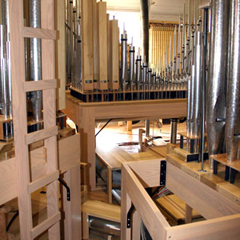 After testing is finished, we disassemble the entire organ and carefully identify and wrap each component for shipping. The organ will probably fill three semi-trailer trucks for its trip to Kansas City. Four members of our team will spend two months on site in Kansas City installing the organ. They will call on some additional local help to raise heavy components to their location. It’s a gigantic construction that will take up to eight weeks to complete and adjust to a very high precision, much like a clock. But even then we’re still not finished.
After testing is finished, we disassemble the entire organ and carefully identify and wrap each component for shipping. The organ will probably fill three semi-trailer trucks for its trip to Kansas City. Four members of our team will spend two months on site in Kansas City installing the organ. They will call on some additional local help to raise heavy components to their location. It’s a gigantic construction that will take up to eight weeks to complete and adjust to a very high precision, much like a clock. But even then we’re still not finished.
We will then tonally finish the instrument: establishing and refining internal tonal balances while making the organ “fit” with the hall’s acoustics and fullfilling the musical needs of the orchestra. I’ll be on site to supervise the tonal finishing of the instrument. Namely, this is to provide the generous sound and power that an orchestra will require, while the organ is used as a solo instrument with the orchestra, or being part of the orchestra, playing sometimes an accompanimental role, or simply crowning the orchestra in large ensembles. During that period, the organ will be played with the Symphony as part of the voicing process.
And then it’s ready for us to enjoy?
Then we hope that the instrument will be used regularly, in various concert presentations with and without the Symphony, and that it will be accessible to other musicians as well. We hope that the instrument will be an inspiration to musicians and to composers, and that it will be a very fine, grand instrument that will engage and delight the many generations to come. We are sparing no efforts to accomplish this.
Read another story about the concert hall organ.